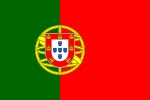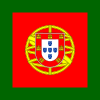Portuguese navy
| Portuguese Navy Marinha Portuguesa Armada Portuguesa |
|
|---|---|

Portuguese Navy coat of arms
|
|
| Founded | 12th century |
| Country | Portugal |
| Branch | Navy |
| Size |
Personnel: |
| Part of | Portuguese Armed Forces |
| Garrison/HQ | Lisbon Naval Base |
| Patron | Henry the Navigator |
| Motto(s) | Ships motto: Honrai a Pátria que a Pátria vos contempla (Honor the Fatherland for the Fatherland beholds you) Heraldic motto: Talant de bien faire (Talent of doing well) Battle cry: São Jorge (Saint George) |
| Anniversaries | 20 May (Discovery of the sea route to India by Vasco da Gama) |
| Commanders | |
| Current commander |
Admiral Luís M. F. Macieira Fragoso |
| Insignia | |
| Naval ensign |  |
| Naval pennant | |
| Naval jack |  |
Personnel:
Military: 8900
Paramilitary: 1000
Civilian: 2700
Equipment:
Frigates: 5
Submarines: 2
Patrol vessels: 21
Landing craft: 1
Support ships: 1
Research vessels: 4
Sail ships: 3
Auxiliary vessels: 50
The Portuguese Navy (Portuguese: Marinha Portuguesa, also known as Marinha de Guerra Portuguesa or as Armada Portuguesa) is the naval branch of the Portuguese Armed Forces which, in cooperation and integrated with the other branches of the Portuguese military, is charged with the military defense of Portugal.
The Portuguese Navy, tracing back to the 12th century, is one of the oldest continuously serving navies in the world. The navy played a key role at the beginning and during the great voyages of the Age of Discoveries in the 15th and 16th centuries. The resulting of this technical and scientific discoveries led Portugal to develop advanced ships, including the caravel, new and more sophisticated types of carracks for interoceanic travel and the oceanic galleon, and to find the sea route to the East and routes to South America and Northern North America.
Bartolomeu Dias rounded the southern tip of Africa and Vasco da Gama reached India, linking Europe and Asia for the first time by ocean route, as well as the Atlantic and the Indian oceans. This led to the discovery of Brazil in the first expeditions that linked Europe, Africa, the New World, and Asia on a single voyage, such as the expedition of Pedro Álvares Cabral, and through the skills and experience of their navigators in the Atlantic, the Indian ocean, and in the Far East, also contributed to the technical and geographical advance of other European navies, such as the first circumnavigation by Ferdinand Magellan (including, in the expedition, other captains, sailors and pilots), sailing across the Atlantic and the Pacific Ocean.
...
Wikipedia
